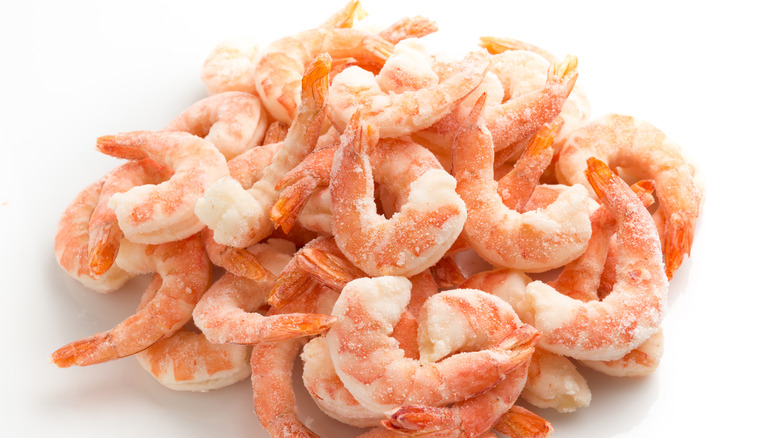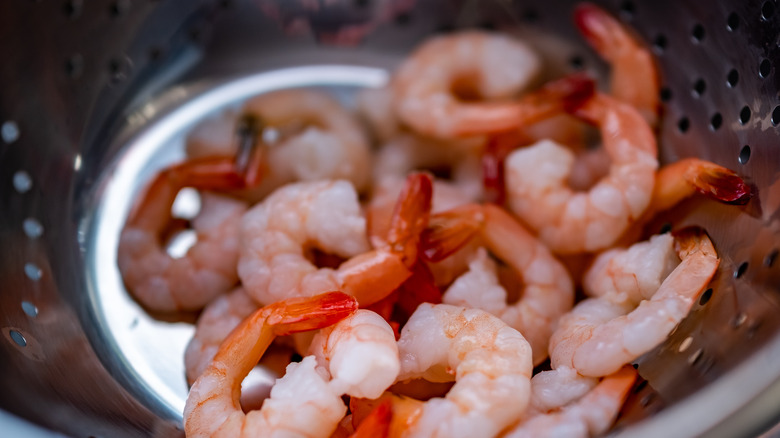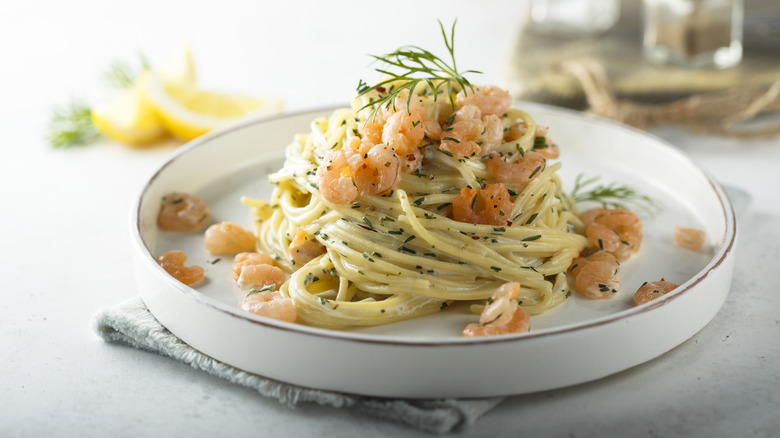Yes, There Is A Correct Way To Thaw Frozen Shrimp
When it comes to getting a quick-and-easy meal on the dinner table in a flash, it's hard to beat frozen shrimp. Not only is shrimp a delicious source of lean protein, but you can stock up on the frozen variety, keeping a bag or two on hand for simple meals and elegant appetizers.
Of course, those handy-dandy frozen shrimp need to be thawed before cooking — and there is a correct way to thaw shrimp, in addition to some less than ideal, but also safe ways. For best results, the U.S. Food & Drug Administration recommends thawing overnight in the fridge. (You may want to remove shrimp from the bag and place in a colander to avoid the shrimp soaking in their own juices.)
Pressed for time but still want to practice safe shrimp? They can also be thawed in the bag in cold water for 30 minutes, or out of the bag in cold water for 15 minutes. However, be sure to note that thawing shrimp directly in cold water may cause the shellfish to take on excess moisture. Regardless, you will want to make sure that the shrimp are thoroughly patted dry before cooking. To help remove any excess moisture, some chefs recommend "flash cooking" the shrimp before incorporating into a recipe. This method involves sauteing the shrimp on high heat for just a minute or two to allow some of that extra water to be released before removing them from the pan, leaving the juices behind.
How to thaw and store shrimp safely
Even if it's dinner time and you forgot to thaw your shrimp overnight per FDA recommendations, don't give in to the temptation to try to speed up the process too much. For instance, frozen shrimp do not need to see the inside of a microwave unless your goal is a rubbery, partially cooked result — nor do you want to use warmer water or let them thaw at room temperature.
Shrimp are considered fully thawed when the exterior looks translucent and free of ice crystals, and they are nice and pliable – indicating that the shrimp are thawed all the way through. Once you've got them thawed out, it's just as important to ensure safe food handling practices with shrimp before and after cooking. Raw shrimp should be cooked within one to two days, while cooked shrimp can be stored in the fridge for three to four days. However, if you smell an ammonia-like odor or notice a slimy texture on raw or cooked shrimp, please do yourself (and your stomach) a favor and toss them in the garbage.
How to cook with frozen shrimp
One of the best things about frozen shrimp is that they can be used in just about any recipe that calls for fresh shrimp. Craving a little Cajun flavor? Keeping a few bags of frozen shrimp on hand makes whipping up this Lousiana shrimp étouffée a breeze. Salt and pepper shrimp stir-fry makes for a super-fast meal when served over rice. (Pro tip: Look for pre-shelled frozen shrimp for even easier meal prep.) While bagged frozen shrimp might seem somehow inferior to the pans of shrimp displayed on ice at your local grocer's seafood counter, that's actually not true. Unless you live near the coast, nearly all "fresh" shrimp sold at the grocery store was once frozen.
If you truly don't have time to thaw frozen shrimp, they can be cooked directly from the freezer. A good lowcountry shrimp boil is ideal for this scenario, since the frozen shrimp can be added just before removing the boil from the heat and allowed a few extra minutes to cook. Frozen shrimp can also be cooked directly in an air fryer.
The most important thing to remember is that like all shellfish, shrimp cook quickly and can be overcooked in no time. For best results, keep a close eye on them while cooking; when the shrimp begin to curl and lose their translucency, turning orange or pink – they're done.



